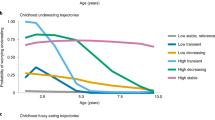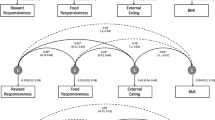Abstract
Studies based on twins are ideal to disentangle the relative contribution of different factors in the development of eating behaviors. This study aims to evaluate if changes in problematic eating behaviors from 4 to 7 years old are more influenced by the genetics, the shared environment of twins, or by individual characteristics of each twin. A total of 86 caregivers (mostly mothers) of twins from the Generation XXI birth cohort provided information on eating behaviors at 4 and 7 years of age. A score of problematic eating behaviors was developed. The Common fate model and the ACE model were used to estimate the effect of shared, individual, and genetic characteristics on changes in eating behaviors. At the dyadic level (shared), the eating behavior score at 4 years old was significantly and positively associated with the eating behavior at 7 years of age (β = 0.402, 95% CI 0.063;0.657). At the individual level, no significant association was observed (β = 0.020, 95% CI −0.078;0.125). The ACE model also showed the shared environment as the major responsible for the changes in eating behaviors from 4 to 7 years old. It also showed that genetic characteristics decreased their relevance overtime. This study supports that changes in eating behaviors from 4 to 7 years of age are mostly associated with the shared environment rather than individual characteristics of each twin. These results are important to improve future strategies to promote healthy environments.
This is a preview of subscription content, access via your institution
Access options
Subscribe to this journal
Receive 12 print issues and online access
$259.00 per year
only $21.58 per issue
Buy this article
- Purchase on SpringerLink
- Instant access to full article PDF
Prices may be subject to local taxes which are calculated during checkout



Similar content being viewed by others
Data availability
The datasets analyzed during the current study are available from the corresponding author on reasonable request.
References
Dewey KG. The challenge of meeting nutrient needs of infants and young children during the period of complementary feeding: an evolutionary perspective. J Nutr. 2013;143:2050–4.
Birch L, Savage JS, Ventura A. Influences on the development of children’s eating behaviours: from infancy to adolescence. Can J Diet Pract Res. 2007;68:s1–s56.
Dubois L, Diasparra M, Bedard B, Kaprio J, Fontaine-Bisson B, Tremblay R, et al. Genetic and environmental influences on eating behaviors in 2.5- and 9-year-old children: a longitudinal twin study. Int J Behav Nutr Phys Act. 2013;10:134.
Wood AC. Gene-environment interplay in child eating behaviors: what the role of “Nature” means for the effects of “Nurture”. Curr Nutr Rep. 2018;7:294–302.
Wood A. Appetitive traits: genetic contributions to pediatric eating behaviors. In: Lumeng JC, Fisher JO, editors. Pediatric food preferences and eating behaviors. Amsterdam: Elsevier Inc.; 2018. p. 127–46.
Lewinsohn PM, Holm-Denoma JM, Gau JM, Joiner TE Jr., Striegel-Moore R, Bear P, et al. Problematic eating and feeding behaviors of 36-month-old children. Int J Eat Disord. 2005;38:208–19.
Oliveira A, de Lauzon-Guillain B, Jones L, Emmett P, Moreira P, Ramos E, et al. Birth weight and eating behaviors of young children. J Pediatr. 2015;166:59–65.
Brown R, Ogden J. Children’s eating attitudes and behaviour: a study of the modelling and control theories of parental influence. Health Educ Res. 2004;19:261–71.
Steptoe A, Pollard TM, Wardle J. Development of a measure of the motives underlying the selection of food: the food choice questionnaire. Appetite. 1995;25:267–84.
Kelder SH, Perry CL, Klepp KI, Lytle LL. Longitudinal tracking of adolescent smoking, physical activity, and food choice behaviors. Am J Public Health. 1994;84:1121–6.
Nicklas TA. Dietary studies of children and young adults (1973-1988): the Bogalusa Heart Study. Am J Med Sci. 1995;310:S101–8.
Llewellyn CH, van Jaarsveld CH, Johnson L, Carnell S, Wardle J. Nature and nurture in infant appetite: analysis of the Gemini twin birth cohort. Am J Clin Nutr. 2010;91:1172–9.
Carnell S, Haworth CM, Plomin R, Wardle J. Genetic influence on appetite in children. Int J Obes. 2008;32:1468–73.
Llewellyn CH, van Jaarsveld CH, Boniface D, Carnell S, Wardle J. Eating rate is a heritable phenotype related to weight in children. Am J Clin Nutr. 2008;88:1560–6.
Costa A, Severo M, Oliveira A. Food parenting practices and eating behaviors in childhood: a cross-lagged approach within the Generation XXI cohort. Am J Clin Nutr. 2021;114:101–108.
Larsen PS, Kamper-Jorgensen M, Adamson A, Barros H, Bonde JP, Brescianini S, et al. Pregnancy and birth cohort resources in europe: a large opportunity for aetiological child health research. Paediatr Perinat Epidemiol. 2013;27:393–414.
Albuquerque G, Severo M, Oliveira A. Early life characteristics associated with appetite-related eating behaviors in 7-year-old children. J Pediatr. 2017;180:38–46 e2.
Peeters H, Van Gestel S, Vlietinck R, Derom C, Derom R. Validation of a telephone zygosity questionnaire in twins of known zygosity. Behav Genet. 1998;28:159–63.
MacCallum RC, Widaman KF, Zhang SB, Hong SH. Sample size in factor analysis. Psychol Methods. 1999;4:84–99.
Meade AW, Bauer DJ. Power and precision in confirmatory factor analytic tests of measurement invariance. Struct Equ Modeling. 2007;14:611–35.
Ledermann T, Kenny DA. The common fate model for dyadic data: variations of a theoretically important but underutilized model. J Fam Psychol. 2012;26:140–8.
Steiger JH. Structural model evaluation and modification: an interval estimation approach. Multivar Behav Res. 1990;25:173–80.
Tucker LR, Lewis CJP. A reliability coefficient for maximum likelihood factor analysis. Psychometrika. 1973;38:1–10.
Bentler PM. Fit indexes, lagrange multipliers, constraint changes and incomplete data in structural models. Multivar Behav Res. 1990;25:163–72.
Hu LT, Bentler PM. Cutoff criteria for fit indexes in covariance structure analysis: conventional criteria versus new alternatives. Struct Equ Modeling Multidiscip J. 1999;6:1–55.
Browne MW, Cudeck R. Alternative ways of assessing model fit. Sociol Methods Res. 1992;21:230–58.
Bates TC, Maes H, Neale MC. umx: twin and path-based structural equation modeling in R. Twin Res Hum Genet. 2019;22:27–41.
Koo TK, Li MY. A guideline of selecting and reporting intraclass correlation coefficients for reliability research. J Chiropr Med. 2016;15:155–63.
de Castro JM, Lilenfeld LR. Influence of heredity on dietary restraint, disinhibition, and perceived hunger in humans. Nutrition. 2005;21:446–55.
Neale BM, Mazzeo SE, Bulik CM. A twin study of dietary restraint, disinhibition and hunger: an examination of the eating inventory (three factor eating questionnaire). Twin Res. 2003;6:471–8.
Plomin R, Rowe DC. A twin study of temperament in young children. J Psychol. 1977;97:107–13.
Breen FM, Plomin R, Wardle J. Heritability of food preferences in young children. Physiol Behav. 2006;88:443–7.
Lucas PJ, Patterson E, Sacks G, Billich N, Evans CEL. Preschool and school meal policies: an overview of what we know about regulation, implementation, and impact on diet in the UK, Sweden, and Australia. Nutrients. 2017;9:736.
Haddad J, Ullah S, Bell L, Leslie E, Magarey A. The influence of home and school environments on children’s diet and physical activity, and body mass index: a structural equation modelling approach. Matern Child Health J. 2018;22:364–75.
Driessen CE, Cameron AJ, Thornton LE, Lai SK, Barnett LM. Effect of changes to the school food environment on eating behaviours and/or body weight in children: a systematic review. Obes Rev. 2014;15:968–82.
Herle M, Fildes A, Steinsbekk S, Rijsdijk F, Llewellyn CH. Emotional over- and under-eating in early childhood are learned not inherited. Sci Rep. 2017;7:9092.
Carnell S, Wardle J. Appetite and adiposity in children: evidence for a behavioral susceptibility theory of obesity. Am J Clin Nutr. 2008;88:22–9.
Llewellyn C, Wardle J. Behavioral susceptibility to obesity: gene-environment interplay in the development of weight. Physiol Behav. 2015;152:494–501.
Smith AD, Fildes A, Cooke L, Herle M, Shakeshaft N, Plomin R, et al. Genetic and environmental influences on food preferences in adolescence. Am J Clin Nutr. 2016;104:446–53.
Elder SJ, Neale MC, Fuss PJ, Lichtenstein AH, Greenberg AS, McCrory MA, et al. Genetic and environmental influences on eating behavior - a study of twin pairs reared apart or reared together. Open Nutr J. 2012;6:59–70.
Kehoe, J. Basic item analysis for multiple-choice tests. Practical Assessment, Research & Evaluation. 1995;4.
Acknowledgements
The authors gratefully acknowledge the families enrolled in Generation XXI for their kindness, all members of the research team for their enthusiasm and perseverance and the participating hospitals and their staff for their help and support. Generation XXI was funded by Programa Operacional de Saúde – Saúde XXI, Quadro Comunitário de Apoio III and Administração Regional de Saúde Norte (Regional Department of Ministry of Health). It has support from the Portuguese Foundation for Science and Technology and from the Calouste Gulbenkian Foundation.
Funding
This study was supported through FEDER from the Operational Programme Factors of Competitiveness – COMPETE and through national funding from the Foundation for Science and Technology – FCT (Portuguese Ministry of Education and Science) under the projects “Appetite regulation and obesity in childhood: a comprehensive approach towards understanding genetic and behavioral influences” (POCI-01-0145-FEDER-030334); “Appetite and adiposity - evidence for gene-environment interplay in children” (IF/01350/2015); Reference: PTDC/SAU-PUB/29567/2017); “HIneC: when do health inequalities start? Understanding the impact of childhood social adversity on health trajectories from birth to early adolescence” (POCI-01-0145-FEDER-029567; Reference: PTDC/SAU-PUB/29567/2017), and through Investigator Contract (IF/01350/2015 - AO). It was also funded by the European Community’s Seventh Framework Programme under Grant Agreement No. 603946 (FP7-2013, HEALS project) and by the PhD Grant PD/BD/135,925/2018 (Cláudia Ribeiro) funded by FCT. In addition, this research was also supported by the Unidade de Investigação em Epidemiologia - Instituto de Saúde Pública da Universidade do Porto (EPIUnit) trought FCT UIDB/04750/2020 and LA/P/0064/2020.
Author information
Authors and Affiliations
Contributions
All the authors have read and approved the paper and it has not been published previously nor is it being considered by any other peer-reviewed journal. CR: investigation, writing- original draft preparation; MS: formal analysis, methodology; AO: writing – review & editing; HB: writing – review & editing; ER: conceptualization; writing – review & editing, supervision; project administration, funding acquisition.
Corresponding author
Ethics declarations
Competing interests
The authors declare no competing interests.
Additional information
Publisher’s note Springer Nature remains neutral with regard to jurisdictional claims in published maps and institutional affiliations.
Rights and permissions
Springer Nature or its licensor holds exclusive rights to this article under a publishing agreement with the author(s) or other rightsholder(s); author self-archiving of the accepted manuscript version of this article is solely governed by the terms of such publishing agreement and applicable law.
About this article
Cite this article
Ribeiro, C., Severo, M., Oliveira, A. et al. Are problematic eating behaviors from 4- to 7-year-old explained by genetic, shared factors or individual characteristics? A longitudinal twin study. Eur J Clin Nutr 77, 82–89 (2023). https://doi.org/10.1038/s41430-022-01192-5
Received:
Revised:
Accepted:
Published:
Issue Date:
DOI: https://doi.org/10.1038/s41430-022-01192-5



